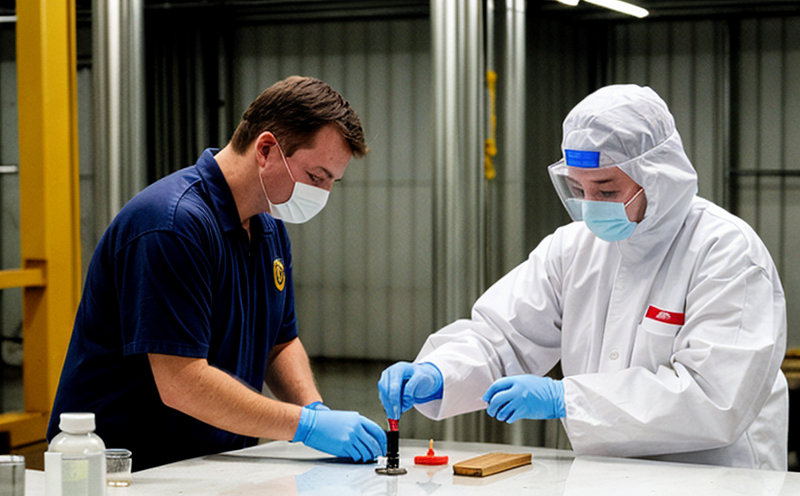ASTM D4332-17 High-Low Temperature Test
The ASTM D4332-17 high-low temperature test is a critical procedure used to evaluate the resistance of packaging materials to extreme temperature variations. This standardized method is essential for ensuring that packaging materials can withstand harsh environmental conditions, thereby protecting the integrity and safety of the products they contain.
This test involves subjecting packaging samples to cycles of low temperatures followed by high temperatures, simulating real-world storage and shipping environments. The objective is to observe changes in the physical properties of the packaging material under these varying thermal conditions, including potential deformation, cracking, or other signs of deterioration.
The ASTM D4332-17 test method specifies a range of temperatures that can be applied, typically between -40°C and 85°C. The exact temperature ranges used in the test may vary depending on the specific requirements of the product being packaged. For instance, pharmaceutical packaging might require more stringent low-temperature testing to ensure stability during cold storage, while food packaging might focus more on high-temperature resilience to prevent spoilage.
The specimen preparation for this test is crucial. Samples are cut into standard dimensions as per ASTM D4332 guidelines and then conditioned at a specified temperature before the beginning of the test. This conditioning ensures that any initial stress on the material due to manufacturing processes or handling is minimized, providing more accurate results.
During the test, specimens undergo a series of temperature cycles. The duration and number of cycles can be adjusted based on the specific needs of the packaging material being tested. After each cycle, samples are visually inspected for any signs of damage or change in properties. Additional tests may also include mechanical strength assessments to evaluate how well the material holds up under these conditions.
The ASTM D4332-17 test is particularly important in sectors such as pharmaceuticals and food manufacturing where product integrity is paramount. By ensuring that packaging materials can withstand extreme temperature variations, manufacturers can enhance shelf life and protect against potential contaminants or spoilage. This not only improves the overall quality of products but also enhances consumer safety.
The results of this test are typically reported in terms of visual observations during each cycle, mechanical strength tests if applicable, and any other relevant parameters specified by ASTM D4332-17 guidelines. These reports serve as critical documentation for compliance with regulatory standards and internal quality control measures.
Why It Matters
The importance of the ASTM D4332-17 high-low temperature test cannot be overstated. In sectors where product integrity is crucial, such as pharmaceuticals and food manufacturing, ensuring that packaging materials can withstand extreme environmental conditions is essential. This not only prolongs the shelf life of products but also enhances consumer safety by preventing potential contaminants or spoilage.
- Enhanced Product Integrity: By testing packaging under real-world temperature variations, manufacturers can ensure that their products remain intact and undamaged during storage and transportation.
- Better Consumer Safety: Packaging materials that fail to withstand extreme temperatures may lead to product spoilage or contamination, posing health risks. Ensuring compliance with ASTM D4332-17 helps mitigate these risks.
- Increased Shelf Life: The ability of packaging to protect products during extended periods at varying temperatures directly impacts the shelf life of goods, reducing waste and improving efficiency in supply chains.
Applied Standards
The ASTM D4332-17 high-low temperature test is widely recognized and applied across various industries. This standard ensures that the testing methodology is consistent, reliable, and repeatable, which is essential for maintaining quality control in packaging design and manufacturing.
Some key points regarding the application of this standard include:
- The test is used to evaluate the resistance of various types of packaging materials such as plastics, metals, foams, and composites.
- The temperature ranges specified in ASTM D4332-17 are designed to simulate real-world conditions that packaging may encounter during storage, transportation, and handling.
- Visual inspections and mechanical strength tests provide comprehensive data on the performance of the packaging materials under extreme temperatures.
Competitive Advantage and Market Impact
- Innovation: Compliance with ASTM D4332-17 encourages continuous improvement in packaging design, leading to innovations that enhance product protection and consumer satisfaction.
- Regulatory Compliance: Ensuring compliance with this standard is crucial for maintaining regulatory standards, which can provide a competitive edge over non-compliant competitors.
- Customer Trust: Companies that demonstrate their commitment to quality by adhering to such rigorous testing protocols gain the trust of their customers and stakeholders, fostering long-term relationships.





